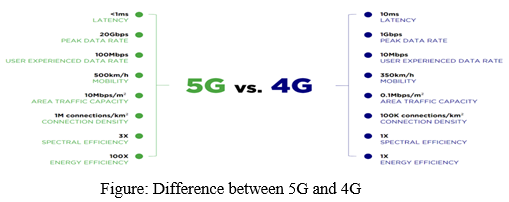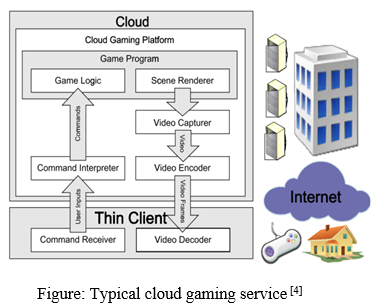Ijraset Journal For Research in Applied Science and Engineering Technology
- Home / Ijraset
- On This Page
- Abstract
- Introduction
- Conclusion
- References
- Copyright
Re-shaping the Gaming Industry after 5G
Authors: Mrs. Raju M, Syed Mohamed Ibrahim Badhusha J, Harini M
DOI Link: https://doi.org/10.22214/ijraset.2022.42142
Certificate: View Certificate
Abstract
The fifth generation of wireless communications (5G) is a revolutionary technology that plays a key role in the development of all sectors, including multimedia and entertainment. These systems have become an existential part of our society, industry, science, and more. On the other hand, intensive research is underway in many aspects of the 5th generation wireless communication network. This network has features with a higher mobile data volume, typical user data rate, number of connected devices, and lower end-to-end latency. There is a growing demand for the development and design of 5G multimedia and entertainment communication applications, technologies, and theories. In the context of 5G wireless communication networks, new theories and technologies support a variety of multimedia applications such as entertainment, gaming and social media, audio and video, medical imaging, surveillance videos, business transactions, and Internet-based streams of things. This paper focuses on the possibilities and outcomes of how 5G makes drastic changes in the gaming sector.
Introduction
I. INTRODUCTION
First, Second, Third, and Fourth Generations of mobile network technologies all led to the Fifth-Generation mobile network technology, which is designed to provide more connectivity than was ever before. It is a unified, more capable air interface that has been designed with an extended capacity to enable next-generation user experiences, deliver new services, and empower new deployment models. 5G is capable of expanding the mobile ecosystem into new realms with high speeds, negligible latency, and superior reliability. 5G will impact every industry, including precision agriculture, making safer transportation, remote healthcare, digitized logistics, multimedia, entertainment, and more into a reality.
II. 5G IN GAMING
5G sets a new global wireless standard. New user experiences and connections to new industries are empowered by improved efficiency and higher performance. 5G is expected to impact nearly every industry, supporting a wide range of industries and potentially enabling up to US$ 13.2 Trillion of global sales activity by 2030. 5G is an advanced network that is structured to connect everyone and everything virtually (including objects, machines, and devices). The 5th generation of mobile network technology is based on OFDM (Orthogonal frequency-division multiplexing) [1]. OFDM is a method of modulating a digital signal across multiple different channels to reduce interference. Alongside OFDM principles, 5G uses a 5G NR (New Radio) air interface to attain outstanding performance compared to LTE. 5G also uses wider bandwidth technologies such as sub-6 GHz (for blanket coverage and bandwidth) and mm-Wave (for higher speeds over shorter distances). Wider bandwidths in 5G will be achieved by expanding the usage of spectrum resources [sub-3 GHz - 100 GHz and beyond][2]. 5G is capable of operating in lower bands as well as mm-Waves. This brings low latency, multi-Gbps throughput, and extreme capacity. Many game developers look at 5G as a foundational technology, that allows innovations and its growth in this field in the future. This means we will be looking at new delivery platforms, new types of games and gameplay, new services for developers and players, new devices, new business models, new innovations in e-Sports, and possibly cross-media collaborations between television, cinema, and the games industry, which are not possible with the current devices and network speeds.

III. EVOLUTION OF TECHNOLOGY AND GAMES
|
Year |
Network |
Games |
|
1990-1999 |
2G networks 1995- introduction of GPRS (171Kbps) 1997-intro of EDGE (384Kbps) [3] |
B&W games, such as Snake and Tetris, were preloaded on mobile phones |
|
2000-2005 |
3G launches first in Japan and Korea (2Mbps) [3] -3G roles out worldwide. -Global revenue in mobile games reaches US$ 1 Billion, 70% is generated in the Asia Pacific. -Many manufacturers build phones for gaming, but without success. |
The first mobile game companies’ kick-off in: - Korea: Com2Us, Gamevil, Zio Interactive -The USA: JAMDAT, Sorrento - Europe: Ludigames (now Gameloft), Handy Games, and Macro space. - Japan: G-mode and existing games companies such as TAITO, and Bandai Namco. The biggest grossing game in the world in 2005 was Tetris. |
|
2006-2009 |
Feature phones are being replaced with smartphones all over the world. 2007- Nokia launches the N-Gage platform which pushes the gaming capabilities of its series 60 smartphones. 2008- The first iPhone is launched and quickly after that, the first Android phones appear. 2009-Nokia discontinues N-Gag TAITO, Bandai Namco. |
-The first large IPs ported to mobile, started having a certain success, such as Metal Gear Solid, winner of the IMGA (International Mobile Gaming Awards) Grand Prix. - Some of these games become classics, such as IMGA winners Edge and Zen Bound. |
|
2010-2013 |
4G starts to roll out, first with 4G LTE (50-75 Mbps) and later with LTE Advanced (150+ Mbps) [3]. -Android and iOS become the dominant platforms. |
The first mobile games worldwide hit launched in this period such as Temple Run, Subway Surfers, Plants vs Zombies, and Angry Birds. Some of them are still in the top 10, such as Clash of Clans and Candy Crush Saga |
|
2014-Today |
The 4G has rolled out fully commercially with a speed of 1Gbps [3]. Today 92.4% of all smartphones are 4G compatible. China has rapidly become the largest market for mobile games. However, regulations introduced in 2018 makes publishing in China difficult for non-Chinese publishers. It can take more than six months before a game gets its authorization. |
-Exponential growth of the number of games available on the app stores: 677,000 on Google Play and 903,489 on the App Store. -Pokémon Go-Brings location-based games to a worldwide audience. -Rich, beautifully designed narrative games flourish as a genre on the App Store such as The Room, The Walking Dead, Old Man’s Journey, and Sky: Children of the Light. |
With the blooming possibilities and the rise of evolution in the gaming industry with 5G, a new era is to be expected. Cloud gaming, E-sports, AR, VR, MR, and XR are the common fields that will have the highest impact on a positive note.
IV. CLOUD GAMING
The Cloud gaming is a streaming service that provides exemplary content at the cost of server capacity and internet bandwidth. The operation of Cloud gaming companies is based on subscriptions. Users pay in order to access advanced hardware to stream the content. The advent of cloud gaming, especially when combined with the deployment of technologies such as 5G, creates a strategic imperative for CSPs (communication service providers) [4] and technology players to create a new service, a new revenue stream, a new market, and above all, a revolutionary opportunity that will set them apart from the competition. Apart from CSPs and technology providers, all consumer-oriented industries are exploring cloud gaming as a new proposition to connect, monetize, engage, and create a differentiation in the changing digital world [2].

In 5G cloud gaming, the following could be seen:
- 5G cloud gaming experience will provide ease in the gaming experience with instant play with no downloads or installations; storage on the cloud, faster and low-cost deployments with connected devices support.
- Superior bandwidth and negligible latency significantly improve gaming experience.
- Improve the quality of games, the ability to feel a new experience with high-end titles, building immersive and interactive, high resolution and overall smoother gaming experience.
- The rise in cloud gaming with the development of AR/VR will enable higher realism and a new game world.
- Extreme personalization with edge-based analytics, social playing will turn spectators into active gamers.
- Trust and safety are ensured by the protection of personal data and cybersecurity.
5G is evolving, it is a journey in cloud gaming. 5G cloud gaming approach supports all game genres from hyper-casual to the high-end genres even when streamed over mobile networks. The architecture and technology are scalable, future-proof, and low cost to ensure ROI (return on investment) without compromising the gamers’ experience [4].
V. E-SPORTS
E-sports is an encompassing term that describes competitive video gaming but it is also the industry that surrounds the skill-building path, that avid gamers follow as they aspire to become professional gamers. E-sports has taken over the world in an astonishing way and is here to stay.
The usual E-sports gameplays are on powerful PCs or consoles but now mobile E-sports games are on rising. The development of 5G networks increases mobile gaming capabilities and drives the popularity of mobile E-sports and mobile-based tournaments too.
The decisive factors for E-sports players and professionals are balanced connections and network environments [5]. With raw speeds of 10Gbps, approximately 10 times that of 4G, gamers can expect uninterrupted and smooth play.
Additionally, to combative gameplays, systems at E-sports tournaments are required to perform several functions, it includes spectators, commentators viewing the live stream (remote as well as onsite), live streaming to onsite jumbotrons (large display screens), media coverage, etc.
1. 5G makes use of mm-Wave, which can provide more capacity while handling a significantly large number of gamers. Since there is heavy congestion for lower frequencies (e.g., with radio and TV signals), mm-Wave uses a faster, wider bandwidth. It is super effective in microscale multitudinous areas with high concentrations of users (e.g., Internet gaming cafes, E-sports competition venues, etc.). Offloading gaming traffic in heavily congested areas will be done by an unlicensed spectrum [6].
2. With 5G's capacity increased as much as 100 times in traffic and network efficiency over 4G, 5G poises to support the sheer number of live streaming required for both offsite and onsite viewers [6].
3. 5G network slicing allows the dynamic configuration of a network based on priorities and gaming traffic conditions. Also, AI helps in identifying and accelerating gaming network traffic. Network slicing also allows audience members at an E-sports venue to enjoy 3D augmented experiences, time-lapse capabilities, 360-degree views of the gameplay, instant replays on their own mobile devices, and the ability to actually join in by playing the game from their seats [6].
VI. AUGMENTED AND VIRTUAL REALITY IN GAMING
|
Terms |
Definitions |
|
Augmented Reality |
AR enhances the view of the real world by overlaying what is seen with computer-generated information. AR applications require the user to hold their phone in front of them [7]. The image is taken by the camera and is processed in real-time, allowing the app to display contextual information or deliver gaming and social experiences that appear to be rooted in the real world [8]. |
|
Virtual Reality |
VR replaces a user’s view by immersing them within a computer-generated virtual environment. This type of XR (Extended Reality) technology has existed for a while, with gradual improvements. It is used primarily for entertainment experiences, such as gaming, concerts, films, or sports but it’s also accelerating into the social domain [7]. |
|
Mixed Reality |
MR is in-between AR and VR, as it merges the real and virtual worlds. There are three key scenarios for this type of XR technology. The first one is a smartphone or AR wearable device with virtual objects and characters superimposed into real-world environments, or potentially vice versa. Mixed reality is beginning to enable VR real-world players to superimpose into video games by bringing real-world personalities into game streaming platforms such as YouTube or Twitch [11]. |
|
Extended Reality |
XR enhances or replaces our view of the world by overlaying or immersing computer text and graphics in real-world and virtual environments, or a combination of both. XR contains AR (augmented reality), VR (virtual reality), and MR (mixed reality). While all three ‘realities’ share common requirements, and conjoining features each has different underlying technologies and purposes [9]. |
VR, AR, MR, and XR are industries that are set to grow profoundly in the coming years, with predictions of more than 100 billion U.S. dollars over the upcoming decade. With this super speed, latency decreases to unfathomable amounts. AR and VR needs reduced ultra-low latency and higher bandwidth to perform proficiently. There is an anticipation that 5G when compared with 4G, will provide 10 times rise of all the time, 10 times fall in latency and 100 times increase in traffic size. The gamers will love this game experience and along with a better UX comes a greater chance of immersive gaming. These features make 5G a compulsory requirement for AR and VR applications, thus letting the ongoing AR applications to carry a great part of the growing approach towards Cloud [10]. This gives way to renewed and more economical AR applications. The connections between AR and 5G network increases the expertise of automated devices such as robots that would perform better with innovated improvements. We expect that 5G will have a positive impact on the growth of mobile AR and VR games as follows
- 5G will boost the capabilities of the wireless VR headsets to download high-quality graphics and visual effects faster, which will result in a much smoother experience.
- 5G will allow more realistic 3D experiences in AR and MR; for instance, real-time rendering in the cloud of ‘skins’ on buildings, people, and moving objects [11].
- In general, 5G will make VR games more immersive and will enhance the artistic possibilities, simulating a walk in the forest, or better representing human beings.
- More stable connections will allow better multiplayer games in VR and AR.
- Industry initiatives such as Niantic’s Real-World Platform, based on 5G, will boost location-based gaming in combination with AR, using the capacities of real-time rendering that 5G can bring [11].
Conclusion
Businesses, consumers, and governments stand to benefit from the possibilities of 5G technology; its practical applications in the future seem endless. In existing network technology, the full potential for the gaming industry is not attained yet, with 5G it will exponentially increase the gaming experience (E-sports and cloud gaming) for gamers. The present technology has drawbacks in the gaming industry such as lagging in high visual graphics, high latency (4G), etc. These drawbacks are overcome in 5G in addition to boosting game visuals and experiences. In this day and age, AR, VR, MR and XR are slowly introduced into our routine uses. With massive usage of 5G, these cutting-edge technologies will have a prominent impact in day-to-day activities. Thus, 5G technology does not only affect the gaming industry but also affects the technological growth of a nation.
References
[1] Vinayak Pujari,Mr Kajima Tambeand Rajendra Patil “Research Paper on Future of 5G Wireless System” (ISSN 2231-2137): SPECIAL ISSUE: APRIL, 2021 [2] Marepalli Sharath Kumar “Revolution of 5g Wireless Technology-Future Direction” IOSR Journal of Computer Engineering (IOSR-JCE) e-ISSN: 2278-0661, p-ISSN: 2278-8727, Volume 21, Issue 4, Ser. III (Jul - Aug 2019) [3] Botir Usmonov, Radjabov Ozod Sattorivichand Rustamov Umedjon Amrillojonovich “5g Technology Evolution” Conference: 2019 International Conference on Information Science and Communications Technologies (ICISCT), Nov-2019 [4] Wei Cai, (Member, Ieee), Ryan Shea, (Member, Ieee), Chun-Ying Huang, (Member, Ieee), Kuan-Ta Chen, (Senior Member, Ieee), Jiangchuan Liu, (Senior Member, Ieee), Victor C. M. Leung, (Fellow, Ieee), And Cheng-Hsin Hsu, (Senior Member, Ieee) “A Survey on Cloud Gaming: Future of Computer Games”, Aug-2016 [5] Michael G Wagner (Drexel University) “On the Scientific Relevance of eSports.” Proceedings of the 2006 International Conference on Internet Computing & Conference on Computer Games Development, ICOMP 2006, Las Vegas, Nevada, USA, June 26-29, 2006 [6] Max Sjöblomand Juho Hamari “What is eSports and why do people watch it?”, Apirl-2017 [7] Fotis Liarokapis (Cyprus University of Technology) “An exploration from virtual to augmented reality gaming” simulation & gaming, Sage Publications, December, 37(4): 507-533, (2006) [8] Fotis Liarokapis (Cyprus University of Technology) and Sara de Freitas (Coventry University) “An exploration from virtual to augmented reality gaming” Chapter: 10Publisher: IGI GlobalEditors: Martin Ebner, Mandy Schiefner, Jan-2010 [9] Philipp A. Rauschnabel,Reto Felix, Christian Hinsch, andHamza Shahab “What is XR? Towards a Framework for Augmented and Virtual Reality”, Nov-2021 [10] Georgios Pappas (Michigan State University) “Extended Reality (XR) and Gamification in the context of the Internet of Things (IoT) and Artificial Intelligence (AI) - Michigan State University”, Thesis for: Doctor of Philosophy in Electrical & Computer Engineering, Advisor: Josh Siegel, Nov-2021 [11] Elizabeth Bonsignore, Derek L. Hansen, Lennart Nacke, Anastasia Salter, Wayne G. Lutters, Zachary O. Toups “Mixed reality games” CSCW \'12 Computer Supported Cooperative Work, Seattle, WA, USA, February 11-15, 2012 - Companion Volume
Copyright
Copyright © 2022 Mrs. Raju M, Syed Mohamed Ibrahim Badhusha J, Harini M. This is an open access article distributed under the Creative Commons Attribution License, which permits unrestricted use, distribution, and reproduction in any medium, provided the original work is properly cited.

Download Paper
Paper Id : IJRASET42142
Publish Date : 2022-05-02
ISSN : 2321-9653
Publisher Name : IJRASET
DOI Link : Click Here
 Submit Paper Online
Submit Paper Online

